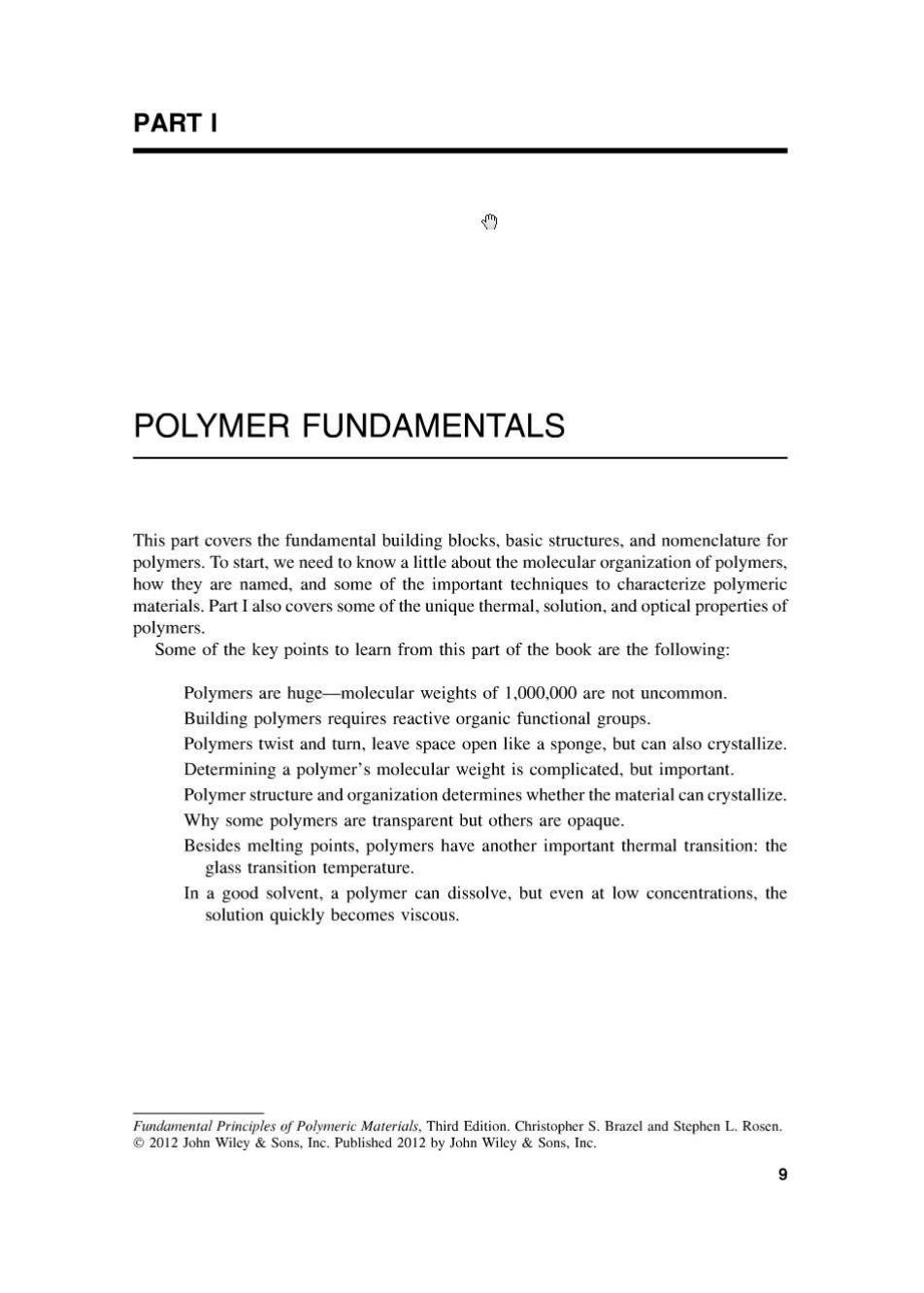
PART I 四 POLYMER FUNDAMENTALS This part covers the fundamental building blocks,basic structures,and nomenclature for polymers.To start,we need to know a little about the molecular organization of polymers, how they are named,and some of the important techniques to characterize polymeric materials.Part I also covers some of the unique thermal,solution,and optical properties of polymers. Some of the key points to learn from this part of the book are the following: Polymers are huge-molecular weights of 1,000,000 are not uncommon. Building polymers requires reactive organic functional groups. Polymers twist and turn,leave space open like a sponge,but can also crystallize. Determining a polymer's molecular weight is complicated,but important. Polymer structure and organization determines whether the material can crystallize. Why some polymers are transparent but others are opaque. Besides melting points,polymers have another important thermal transition:the glass transition temperature. In a good solvent,a polymer can dissolve,but even at low concentrations,the solution quickly becomes viscous. Fundamental Principles of Polymeric Materials,Third Edition.Christopher S.Brazel and Stephen L.Rosen. 2012 John Wiley Sons,Inc.Published 2012 by John Wiley Sons,Inc. 9
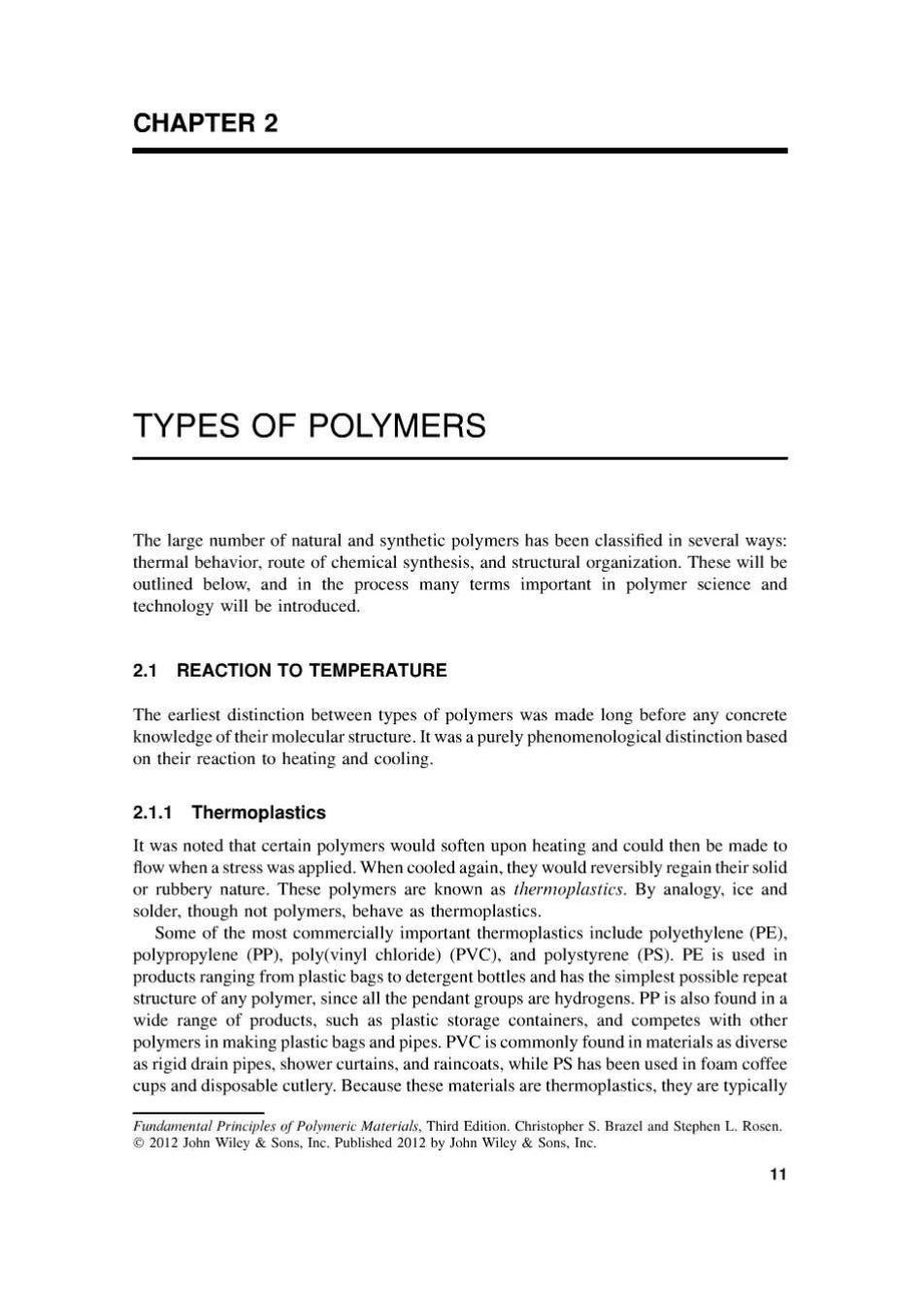
CHAPTER 2 TYPES OF POLYMERS The large number of natural and synthetic polymers has been classified in several ways: thermal behavior,route of chemical synthesis,and structural organization.These will be outlined below,and in the process many terms important in polymer science and technology will be introduced. 2.1 REACTION TO TEMPERATURE The earliest distinction between types of polymers was made long before any concrete knowledge of their molecular structure.It was a purely phenomenological distinction based on their reaction to heating and cooling. 2.1.1 Thermoplastics It was noted that certain polymers would soften upon heating and could then be made to flow when a stress was applied.When cooled again,they would reversibly regain their solid or rubbery nature.These polymers are known as thermoplastics.By analogy,ice and solder,though not polymers,behave as thermoplastics. Some of the most commercially important thermoplastics include polyethylene (PE). polypropylene (PP).poly(vinyl chloride)(PVC),and polystyrene (PS).PE is used in products ranging from plastic bags to detergent bottles and has the simplest possible repeat structure of any polymer,since all the pendant groups are hydrogens.PP is also found in a wide range of products,such as plastic storage containers,and competes with other polymers in making plastic bags and pipes.PVC is commonly found in materials as diverse as rigid drain pipes,shower curtains,and raincoats,while PS has been used in foam coffee cups and disposable cutlery.Because these materials are thermoplastics,they are typically Fundamental Principles of Polymeric Materials,Third Edition.Christopher S.Brazel and Stephen L.Rosen. 2012 John Wiley Sons,Inc.Published 2012 by John Wiley Sons,Inc. 11
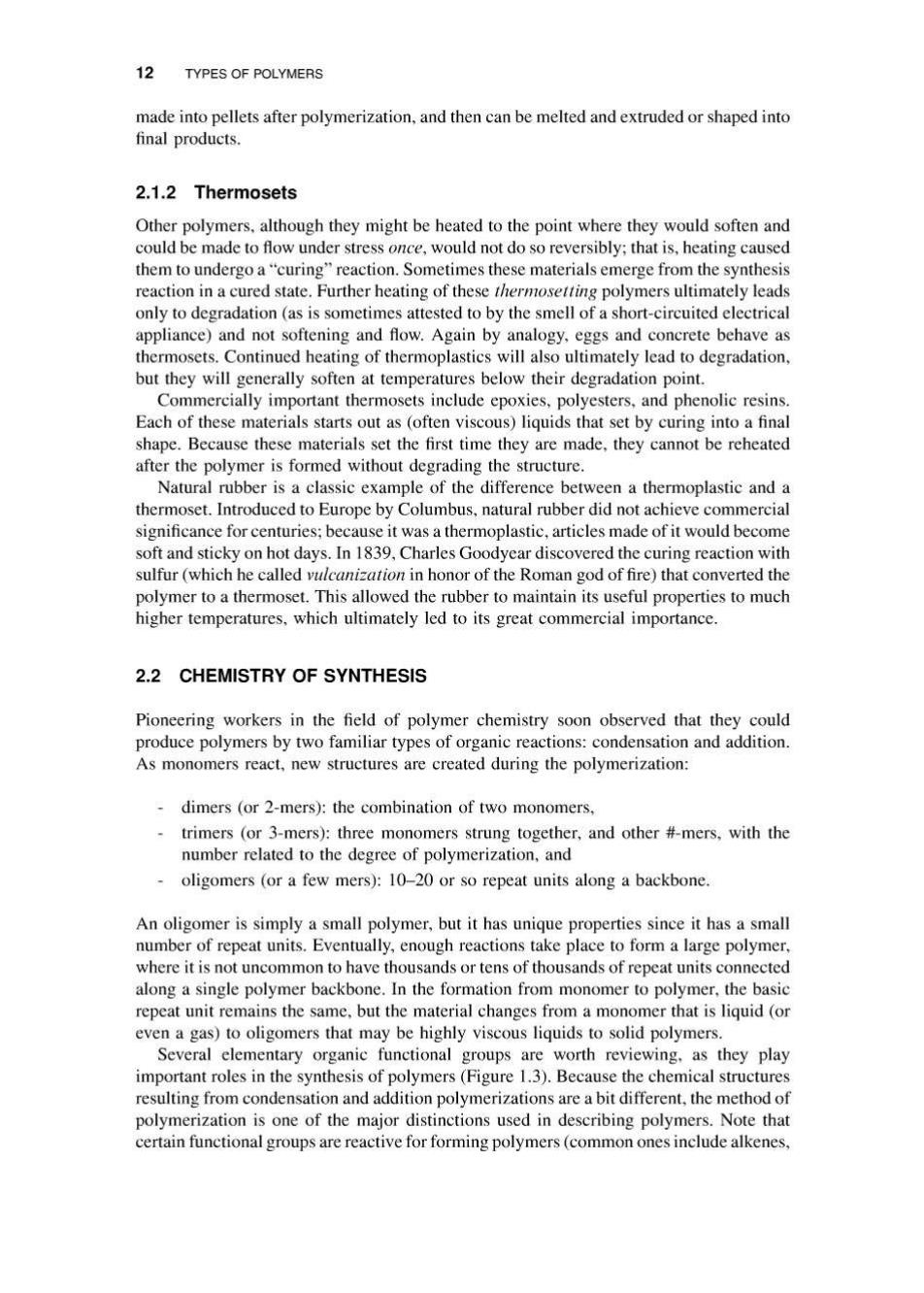
12 TYPES OF POLYMERS made into pellets after polymerization,and then can be melted and extruded or shaped into final products. 2.1.2 Thermosets Other polymers.although they might be heated to the point where they would soften and could be made to flow under stress once,would not do so reversibly;that is,heating caused them to undergo a"curing"reaction.Sometimes these materials emerge from the synthesis reaction in a cured state.Further heating of these thermosetting polymers ultimately leads only to degradation (as is sometimes attested to by the smell of a short-circuited electrical appliance)and not softening and flow.Again by analogy,eggs and concrete behave as thermosets.Continued heating of thermoplastics will also ultimately lead to degradation, but they will generally soften at temperatures below their degradation point. Commercially important thermosets include epoxies,polyesters,and phenolic resins. Each of these materials starts out as (often viscous)liquids that set by curing into a final shape.Because these materials set the first time they are made,they cannot be reheated after the polymer is formed without degrading the structure. Natural rubber is a classic example of the difference between a thermoplastic and a thermoset.Introduced to Europe by Columbus,natural rubber did not achieve commercial significance for centuries;because it was a thermoplastic,articles made of it would become soft and sticky on hot days.In 1839,Charles Goodyear discovered the curing reaction with sulfur(which he called vulcanization in honor of the Roman god of fire)that converted the polymer to a thermoset.This allowed the rubber to maintain its useful properties to much higher temperatures,which ultimately led to its great commercial importance. 2.2 CHEMISTRY OF SYNTHESIS Pioneering workers in the field of polymer chemistry soon observed that they could produce polymers by two familiar types of organic reactions:condensation and addition. As monomers react,new structures are created during the polymerization: dimers (or 2-mers):the combination of two monomers. trimers (or 3-mers):three monomers strung together,and other #-mers,with the number related to the degree of polymerization,and oligomers (or a few mers):10-20 or so repeat units along a backbone. An oligomer is simply a small polymer,but it has unique properties since it has a small number of repeat units.Eventually,enough reactions take place to form a large polymer, where it is not uncommon to have thousands or tens of thousands of repeat units connected along a single polymer backbone.In the formation from monomer to polymer,the basic repeat unit remains the same,but the material changes from a monomer that is liquid (or even a gas)to oligomers that may be highly viscous liquids to solid polymers. Several elementary organic functional groups are worth reviewing.as they play important roles in the synthesis of polymers(Figure 1.3).Because the chemical structures resulting from condensation and addition polymerizations are a bit different,the method of polymerization is one of the major distinctions used in describing polymers.Note that certain functional groups are reactive for forming polymers(common ones include alkenes
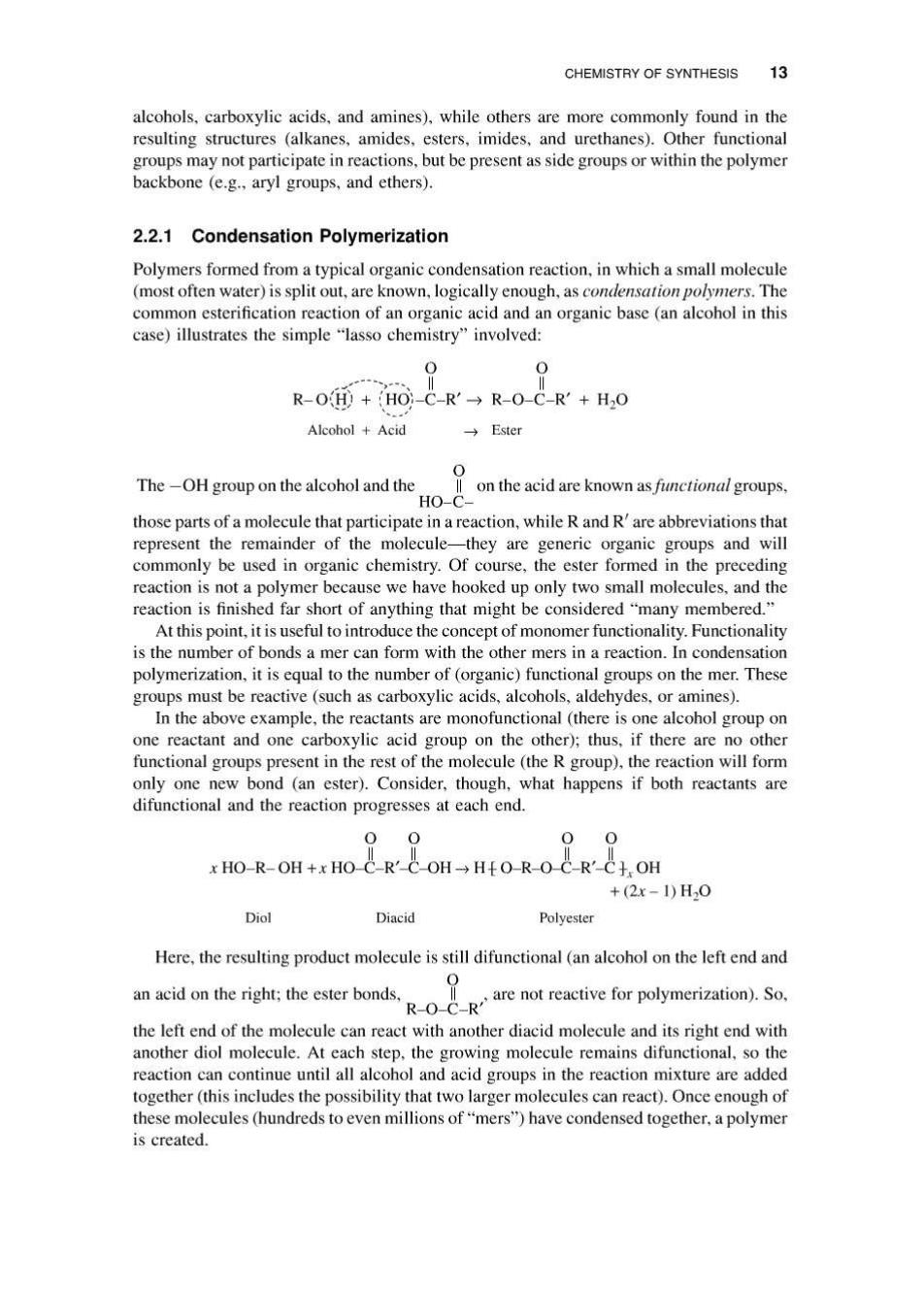
CHEMISTRY OF SYNTHESIS 13 alcohols,carboxylic acids,and amines),while others are more commonly found in the resulting structures (alkanes,amides,esters,imides,and urethanes).Other functional groups may not participate in reactions,but be present as side groups or within the polymer backbone (e.g.,aryl groups,and ethers). 2.2.1 Condensation Polymerization Polymers formed from a typical organic condensation reaction,in which a small molecule (most often water)is split out,are known,logically enough,as condensation polymers.The common esterification reaction of an organic acid and an organic base (an alcohol in this case)illustrates the simple "lasso chemistry"involved: 0 R-OH)+HO-C-R'R-O-C-R'+H2O Alcohol +Acid →Ester O The-OH group on the alcohol and the Il on the acid are known as functional groups, HO-C- those parts of a molecule that participate in a reaction,while R and R'are abbreviations that represent the remainder of the molecule-they are generic organic groups and will commonly be used in organic chemistry.Of course,the ester formed in the preceding reaction is not a polymer because we have hooked up only two small molecules,and the reaction is finished far short of anything that might be considered"many membered." At this point,it is useful to introduce the concept of monomer functionality.Functionality is the number of bonds a mer can form with the other mers in a reaction.In condensation polymerization,it is equal to the number of (organic)functional groups on the mer.These groups must be reactive(such as carboxylic acids,alcohols,aldehydes,or amines). In the above example,the reactants are monofunctional(there is one alcohol group on one reactant and one carboxylic acid group on the other);thus,if there are no other functional groups present in the rest of the molecule(the R group),the reaction will form only one new bond (an ester).Consider,though,what happens if both reactants are difunctional and the reaction progresses at each end. 00 0 0 x HO-R-OH+x HO-C-R'-C-OHH+O-R-O-C-R'-COH +(2x-1)H,O Diol Diacid Polyester Here,the resulting product molecule is still difunctional(an alcohol on the left end and an acid on the right;the ester bonds, R-Rare not reactive for polymerization).So. the left end of the molecule can react with another diacid molecule and its right end with another diol molecule.At each step,the growing molecule remains difunctional,so the reaction can continue until all alcohol and acid groups in the reaction mixture are added together(this includes the possibility that two larger molecules can react).Once enough of these molecules(hundreds to even millions of"mers")have condensed together,a polymer is created
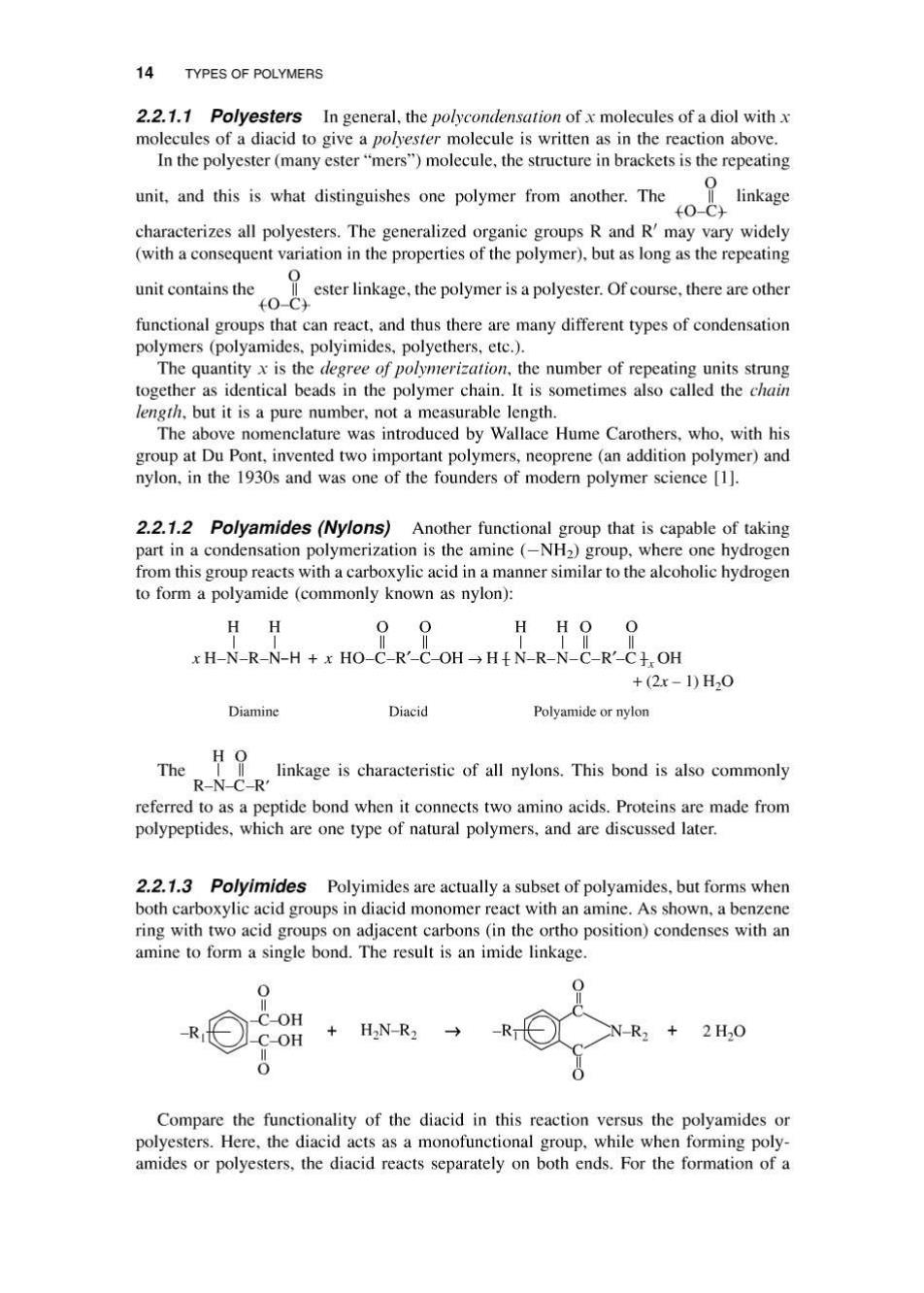
14 TYPES OF POLYMERS 2.2.1.1 Polyesters In general,the polycondensation of x molecules of a diol with x molecules of a diacid to give a polyester molecule is written as in the reaction above. In the polyester(many ester"mers")molecule,the structure in brackets is the repeating 0 unit,and this is what distinguishes one polymer from another.The linkage 4O-C) characterizes all polyesters.The generalized organic groups R and R'may vary widely (with a consequent variation in the properties of the polymer),but as long as the repeating unit conins theester linkage,the polymer isapolyester.fcothere re other 0 O-CY functional groups that can react,and thus there are many different types of condensation polymers (polyamides,polyimides,polyethers,etc.). The quantity x is the degree of polymerization,the number of repeating units strung together as identical beads in the polymer chain.It is sometimes also called the chain length,but it is a pure number,not a measurable length. The above nomenclature was introduced by Wallace Hume Carothers,who,with his group at Du Pont,invented two important polymers,neoprene(an addition polymer)and nylon,in the 1930s and was one of the founders of modern polymer science [1]. 2.2.1.2 Polyamides (Nylons)Another functional group that is capable of taking part in a condensation polymerization is the amine (-NH2)group,where one hydrogen from this group reacts with a carboxylic acid in a manner similar to the alcoholic hydrogen to form a polyamide (commonly known as nylon): H I H 99 HH9。 H-N-R-N-H HOCRCOH-HEN-R-NCR CLOH +(2x-1)H20 Diamine Diacid Polyamide or nylon The linkage is characteristic of all nylons.This bond is also commonly R-N-C-R' referred to as a peptide bond when it connects two amino acids.Proteins are made from polypeptides,which are one type of natural polymers,and are discussed later. 2.2.1.3 Polyimides Polyimides are actually a subset of polyamides,but forms when both carboxylic acid groups in diacid monomer react with an amine.As shown,a benzene ring with two acid groups on adjacent carbons (in the ortho position)condenses with an amine to form a single bond.The result is an imide linkage. OH C-OH +HNR2→ -R + 2H0 Compare the functionality of the diacid in this reaction versus the polyamides or polyesters.Here.the diacid acts as a monofunctional group,while when forming poly- amides or polyesters,the diacid reacts separately on both ends.For the formation of a